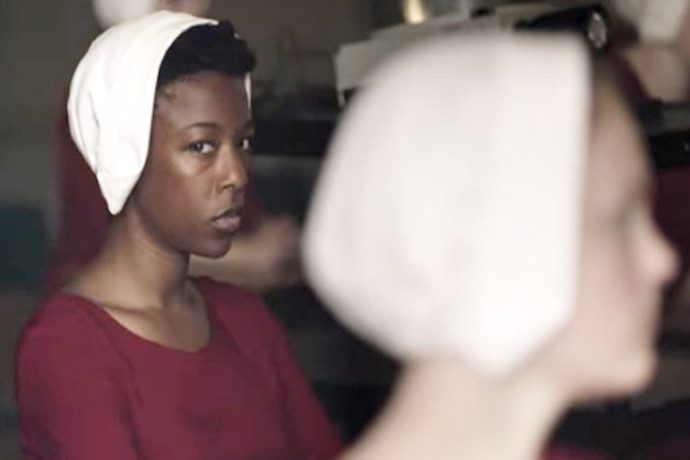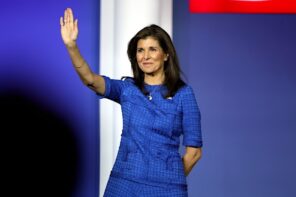The following was originally published on April 25, 2017.
The upcoming release of Hulu’s Handmaid’s Tale miniseries is an opportunity to appreciate the cultural significance—and political prescience—of Margaret Atwood’s famous 1985 novel. As viewers discover, in a near future world wracked by environmental catastrophe and an infertility epidemic, Christian fundamentalists launch a coup in the U.S., killing the president and congress and installing a new, theocratic Republic of Gilead. Leaders of the new state use fertile women as “handmaids” to conceive and bear their children when their wives are not able—even though it’s often the husbands who are actually infertile. The practice follows the biblical precedent of Rachel, who gives her handmaid over to her husband Jacob when she is unable to bear children.
The impetus for the novel (which follows the story of a handmaid called Offred, because she’s assigned to a commander named Fred) was the seismic transformation in postwar American religion: the emergence, from hibernation, of fundamentalist Christianity as an active social and political force in the nation. Beginning in the 1970s, conservative white evangelicals began to organize and make demands across the public sphere. Their demands entailed what to include in public schools (Bible reading and prayer, and not evolution), but they were especially incensed by the sexual revolution of the 1960s, and they pushed back against premarital sex, homosexuality, and especially abortion.
![]() Enter to win a $50 Amazon gift card!
Enter to win a $50 Amazon gift card!
Click HERE to take our 2-minute reader survey.
Though evangelicals (unlike Catholics) initially exhibited a range of responses to Roe v. Wade, moderate evangelicals were activated and radicalized by Francis Schaeffer’s documentary How Should We Then Live in 1977. The 10-part series, directed by his son Frank, was a broad stroke history of the Christian West, concluding with the solemn threat posed to it by abortion and euthanasia. Jerry Falwell and Tim LaHaye’s Moral Majority, founded in 1979, made abortion a central issue, and, in the decades that followed, their pro-life stance became the default position of white evangelicals, and then a central platform of the Republican Party.
The Handmaid’s Tale was Atwood’s thought experiment about what it looked like for the state to take women’s fertility choices away from them. She listened to what the Christian Right was saying about sexuality, gender roles, patriarchy, homosexuality, and the God-given differences between men and women, and imagined an extreme version of a society built around those ideas.
The Christian Right was always about a willingness to legislate for those outside its own group—that was its point. It legislated for creationism to be taught not just to children of conservative Christian households, but to everyone else’s children too; it opposed the acceptance of homosexuality not just within its own congregations, but in the larger society; and its rejection of abortion took the form not just of Christian individuals deciding not to have abortions, but as the chief political goal of overturning Roe v. Wade, preventing access to all women.
In the 2016 election, many analysts believe that it was the all-consuming goal of overturning Roe v. Wade that motivated 81% of white evangelicals to overlook the improprieties and illegalities of the Republican candidate, and ignore a foreign adversary’s intervention to help elect him. Indeed, the specter of the new Congress removing funding for Planned Parenthood has already been compared to the control over women’s fertility choices imagined in Hulu’s Handmaid’s Tale.
Test: which picture is from the trailer for @MargaretAtwood's The Handmaid's Tale, and which one is a photo of Trump's "freedom caucus"? pic.twitter.com/kHbXd8VFZE
— Eleanor Bley Griffiths (@eleanor_bg) March 24, 2017
But it wasn’t only the gendered lines of combat that Atwood recognized in the nascent Christian Right—and this is where Hulu’s adaptation appears to take a self-conscious risk that may ultimately make it the wrong adaptation for the Age of Trump. Margaret Atwood’s novel also carefully noted the racialized history of the Christian Right, which predated its opposition to abortion. In the novel, African Americans are called the “Children of Ham” and are being “resettled” out of Gilead into the less prosperous “National Homeland” formerly known as North Dakota.
It was a reference to the contemporaneous practice of South African apartheid’s formation of homelands, but the phrase invoked the Biblical story of Noah’s curse on Ham, which had been used for centuries to justify policies enforcing the servility of people of African descent to whites. The phrase, in fact, had been used as part of the defense of Christian Segregation in the South after Reconstruction and even, sometimes, into the 1960s. It was used by Jerry Falwell to argue for the Biblical basis of segregation, and against the Civil Rights Movement, before he began politically organizing evangelicals in the 1970s. With some exceptions, like the Schaeffers, many of the leaders of the emergent Christian Right had a heritage in the theological tradition of Christian Segregation.
Atwood famously said of her novel that “there isn’t anything in the book not based on something that has already happened in history or in another country.” This was true of the way Noah’s curse on Ham was used to justify Segregation after the Civil War, but it was especially true of the way it was used by many Southern Christians to justify slavery before that. In fact, Atwood modeled Gilead on the Biblically-sanctioned oppression of slavery, which is why the novel borrows liberally from the details of slave narratives such as Harriet Jacobs’ Incidents in the Life of a Slave Girl and Narrative of the Life of Frederick Douglass.
As in Southern slave culture, in Gilead Christianity is the ideological apparatus used to control subordinate populations—control that works best when the populations accept the religious authorization of the regime. The Bible is an “incendiary” device in Atwood’s novel that the handmaids are forbidden to read, just as literacy was likewise forbidden in many slave households (and therefore highly prized by slaves). The illicit sexual availability of slave women (attested in Jacobs and Douglass) is re-imagined in Atwood’s novel as “Jezebel’s,” a sort of state-run secret prostitution house where commanders can have sex with their handmaids (and other captured women) outside the official conception ceremony. The Underground Railroad organized to enable slaves to escape to Northern freedom likewise has its parallel in the “Underground Femaleroad” in The Handmaid’s Tale, an organization, as before, partly staffed by dissident Christian sects like the Quakers. In both the novel and its historical analogue, Canada remains the ultimate destination.
These many allusions in Atwood’s novel demonstrate her close attention to the Christian Right’s racialized roots, and in this aspect the novel retains its prescience for our current condition. But Hulu has intentionally made the decision to diversify its cast by making Offred’s lesbian friend and sister handmaid Moira African American, thereby downplaying the white supremacist nature of the revolution and the new state of Gilead.
This partly makes sense from an audience point of view; who wants to watch a show with an all-white cast, a kind of dystopian Friends? But by departing from its source material, however, the adaptation risks losing one half of the novel’s critique of the historical politics of the Christian Right. It risks obscuring the continuing reverberations of racial resentment among the white evangelicals who make up the crucial block of Republican voters.
The white Christian South was long obsessed by racial purity, both during slavery and then segregation; it’s one reason anti-miscegenation laws flourished and were understood to have explicit Biblical support. Given this theological heritage, it’s difficult to imagine Gilead’s leaders suddenly accepting mixed-race heirs produced by black handmaids, even in the face of an infertility epidemic.
Executive Producer Bruce Miller has justified the change by suggesting that “The evangelical movement has gotten a lot more integrated” since the novel’s publication. Not only is this is only true to a marginal extent, but Atwood’s point is less about the homogeneity of the evangelical movement in North America than it is about the politics of its power structures and general culture. As the tweet above suggests, comparing Hulu’s Gileadean leaders to the current Republican leadership repealing Planned Parenthood funding, the dynamics are very much about flexing the power of white Christian males. Even the show itself won’t pretend to imagine black fundamentalist men among Gilead’s leadership.
The Trump administration’s prominent and outspoken white nationalists, sympathy for African American voter suppression under the guise of combatting voter fraud, and its racialized policies directed against Muslims, Mexicans, and other minorities, all suggest some continuity with the Christian White supremacy of a bygone era, even if many Trump supporters may not put it to themselves or others like that. Indeed, as Sarah Posner has recently explained, in voting for Trump by 81%, white evangelicals “have returned the religious right to its own origins—as a movement founded to maintain the South’s segregationist ‘way of life.’”
She continues, “By backing Trump, white evangelicals were playing into the hands of a new, alt-right version of Christianity—a sprawling coalition of white nationalists, old-school Confederates, neo-Nazis, Islamophobes, and social-media propagandists who viewed the religious right, first and foremost, as a vehicle for white supremacy.”
It’s too early to tell whether Hulu’s adaptation will try in other ways to capture this other dimension of the Christian Right. What was extraordinary about The Handmaid’s Tale in its time is the clarity with which it saw the new socio-political movement of the Christian Right—its sexual politics, its repressed racial history, its latent authoritarianism. It has no equal in literary fiction in terms of apprehending a nascent political ideology and the way it might transform the nation. How striking that it turned out to be a Canadian novel, rather than a piece of American literature. The Handmaid’s Tale did for the Christian Right what George Orwell’s 1984 did for postwar, dystopic totalitarianism and its ideological apparatus. This American movement, to be sure, wasn’t—and still isn’t—comparable, yet its strains of ideological extremism, certainty, credulity, patriotism, and authoritarianism had echoes in that Cold War context.
It remains to be seen how Hulu’s series updates the novel’s vision of—and resistance to—the empowered Christian Right for the Age of Trump. But with Atwood dropping hints about a Handmaid’s Tale sequel, we may be able to look forward to a season two of defiance.





